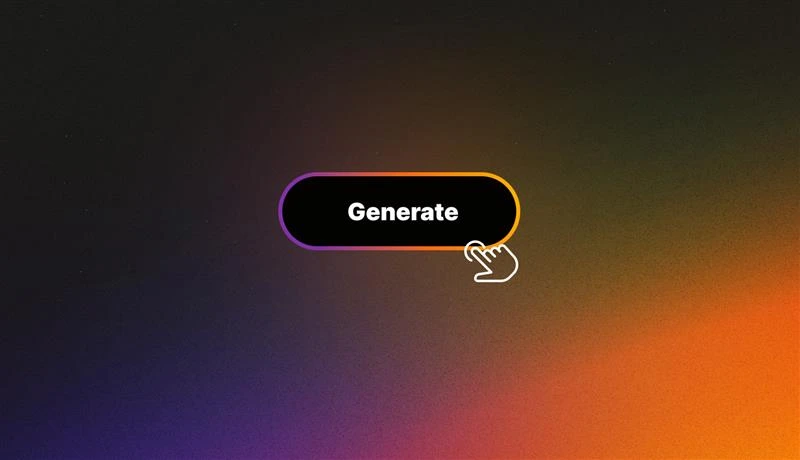The Evolution of Call-to-Action Buttons in the AI Era
“We don’t just push buttons anymore; we generate possibilities. Each click is a gateway to a new reality—one that we shape, not just consume.” This quote, inspired by sci-fi concepts from movies like The Matrix and Tron, encapsulates the empowerment behind the “Generate” button, where users transition from passive actions to becoming active creators of their digital experiences.
In recent years, the “Generate” button has emerged as a defining symbol of modern digital interaction. This article explores the evolution of Call-to-Action (CTA) buttons, from their humble beginnings to the AI-driven present, and examines the psychological and technological factors driving this change.
The Journey of CTAs: From “Click Here” to “Generate”
The Early Days: Simplicity and Direction
In the 1990s, as the internet was finding its footing, CTAs like “Click Here,” “Submit,” and “Download” were crucial for guiding users through basic, static web pages. According to the Nielsen Norman Group, simplicity was paramount during those early days. Users appreciated clear, directive CTAs that helped them navigate an unfamiliar online world. These early buttons served their purpose well, ensuring that people knew exactly what to do, even in the absence of sophisticated design.
The Rise of Engagement: Building Connections
As web design became more sophisticated, CTAs had to evolve to match users’ rising expectations for personalization and engagement. Buttons like “Get Started” or “Join Us” became the norm, reflecting the shift towards building trust and connection. CTAs became more conversational, reflecting brand personality and encouraging a deeper relationship with users.
Personalization Takes Center Stage
With the advent of big data and AI-driven insights, CTAs moved into an era of personalization at scale. Instead of one-size-fits-all buttons, platforms began using personalized CTAs like “Continue Your Journey” or “Discover Your Plan.” Research from Unbounce showed that personalized CTAs can boost conversion rates by up to 42%, which encouraged companies to invest in A/B testing and refine the micro-copy around these buttons to make them more relevant to individual users.
The AI Revolution: Birth of the “Generate” Button
The arrival of AI tools and generative models like OpenAI’s ChatGPT and DALL-E marked a new phase in the evolution of CTAs. The “Generate” button is emblematic of this change, enabling users to actively create personalized content—whether text, images, or even entire artworks—in real time. As Wired highlighted in a 2023 article, this leap forward in interactivity puts creative control directly in users’ hands.
Today’s users crave immediacy, creativity, and personalization, and the “Generate” button delivers on these expectations. Adobe’s 2023 Digital Trends Report found that 60% of users expect on-demand, customizable content, and “Generate” provides just that—an instant, interactive experience.
The Psychology Behind “Generate” as a CTA
From a psychological standpoint, “Generate” implies ownership, creation, and immediate gratification. Unlike older CTAs such as “Submit” or “Download,” which felt purely transactional, “Generate” empowers users by making them active participants.
Research from The Journal of Consumer Psychology suggests that users are more likely to engage with actions that offer them creative agency—turning passive engagement into active involvement. This aligns with the self-determination theory, which posits that autonomy and competence are key motivators for human behavior.
However, while the “Generate” button offers exciting possibilities, it’s not without challenges:
- Quality Control: AI-generated content may not always meet user expectations, potentially leading to frustration.
- Ethical Concerns: Issues around copyright, originality, and the potential for generating harmful content need careful consideration.
- User Overwhelm: Too many options or complex interfaces can lead to decision fatigue.
- Accessibility: Ensuring that “Generate” functions are accessible to all users, including those with disabilities, presents new design challenges.
What’s Next for Call to Action Buttons?
Looking to the future, CTAs will likely continue to become more immersive and interactive. As AI and virtual reality develop, we might see buttons like:
- “Collaborate”: Inviting users to work alongside AI in real-time creation
- “Experience”: Offering fully immersive, personalized virtual experiences
- “Evolve”: Allowing users to iteratively improve AI-generated content
Gartner predicts that by 2027, 75% of enterprises will use AI-driven personalized CTAs to enhance user experience, underscoring the need for continuous innovation in this space.
The evolution from “Click Here” to “Generate” reflects a broader shift in how we interact with technology. As users become more sophisticated and AI capabilities expand, the line between consumption and creation continues to blur.
For businesses and designers, the challenge now is to harness the power of “Generate” and its successors to create meaningful, ethical, and engaging user experiences. As we look to the future, the question isn’t just what the next big CTA will be, but how we can use it to empower users while navigating the complex landscape of AI-driven interaction.
In this new era of digital engagement, the most successful platforms will be those that strike the right balance between automation and human creativity, offering users the tools to generate not just content, but meaningful digital experiences.








